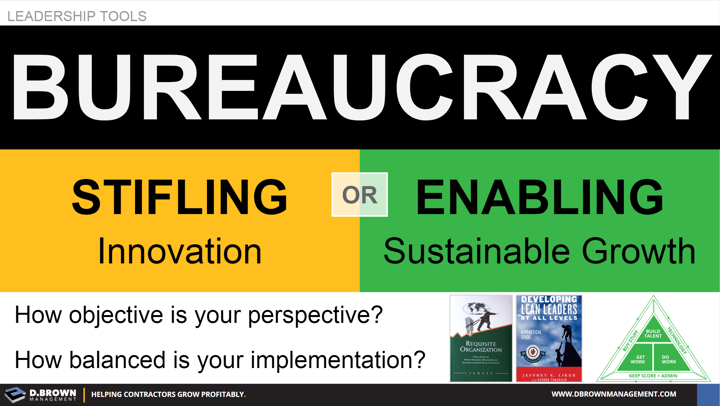Enabling Bureaucracy and hierarchies are designed to support organizational goals by providing structure for efficiency while allowing flexibility and creativity. This provides for scalability, sustainability, and succession.
Stifling Bureaucracy is characterized by excessive red tape and rigidity slowing down decision-making and hindering innovation.
Bureaucracy is like stress - too much AND too little are both bad. Your role in leadership is finding that optimum balance.
Note that the general personality types of "Entrepreneurs" and "Producers" will push back the most against nearly any form of standardization they didn't create and can't change. The "Administrators" will tend to over-process which creates its own problems. The right answer is balance.
Looking at yourself:
- How objective is your perspective?
- How balanced is your implementation?
Every contractor will face a dilution of their management talent density through 2030 before things begin to improve. The competitive advantage will go to those contractors who master the following balance:
- Attracting new top-level talent to the organization raising the overall talent density level.
- Developing talent to increase the density level.
- Adding in the right levels of enabling bureaucracy (management systems) to optimize team performance given the inevitable dilution of talent density that is compounded by growth.
“Bureaucracies are designed to manage yesterday.” - Peter F. Drucker
- This is both a positive and a negative, especially when it comes to making strategic decisions.
- Bureaucracy and hierarchy allow the scaling of your strategic market choices.
- Bureaucracy and hierarchy can easily close your thinking about new strategic possibilities and doom any strategic market experiments to failure.
Elliott Jaques (The Requisite Organization) described effective bureaucracy as requiring the following basic conditions. Simplified bullet points:
- Align management levels and bureaucracy with complexity and scale of the business and projects.
- Roles at different levels of the hierarchy should be distinct in terms of the complexity they handle.
- Match people's skills to job complexity.
- Managers must be able to handle more complex work than their teams to be effective at training, development, and in adding value to their team's decision-making process.
- Managers need control over the people and other resources they are accountable for.
- Interactions between people at the same level must be clearly defined. (Workflow / Responsibility Matrix)
Learn More:
“Bureaucracy constitutes the most efficient and rational way in which one can organize the human activity and that systematic processes and organized hierarchies are necessary to maintain order, maximize efficiency, and eliminate favoritism.
On the other hand, unfettered bureaucracy is a threat to individual freedom, with the potential of trapping individuals in an impersonal "iron cage" of rule-based, rational control.” - Max Weber; German Sociologist

